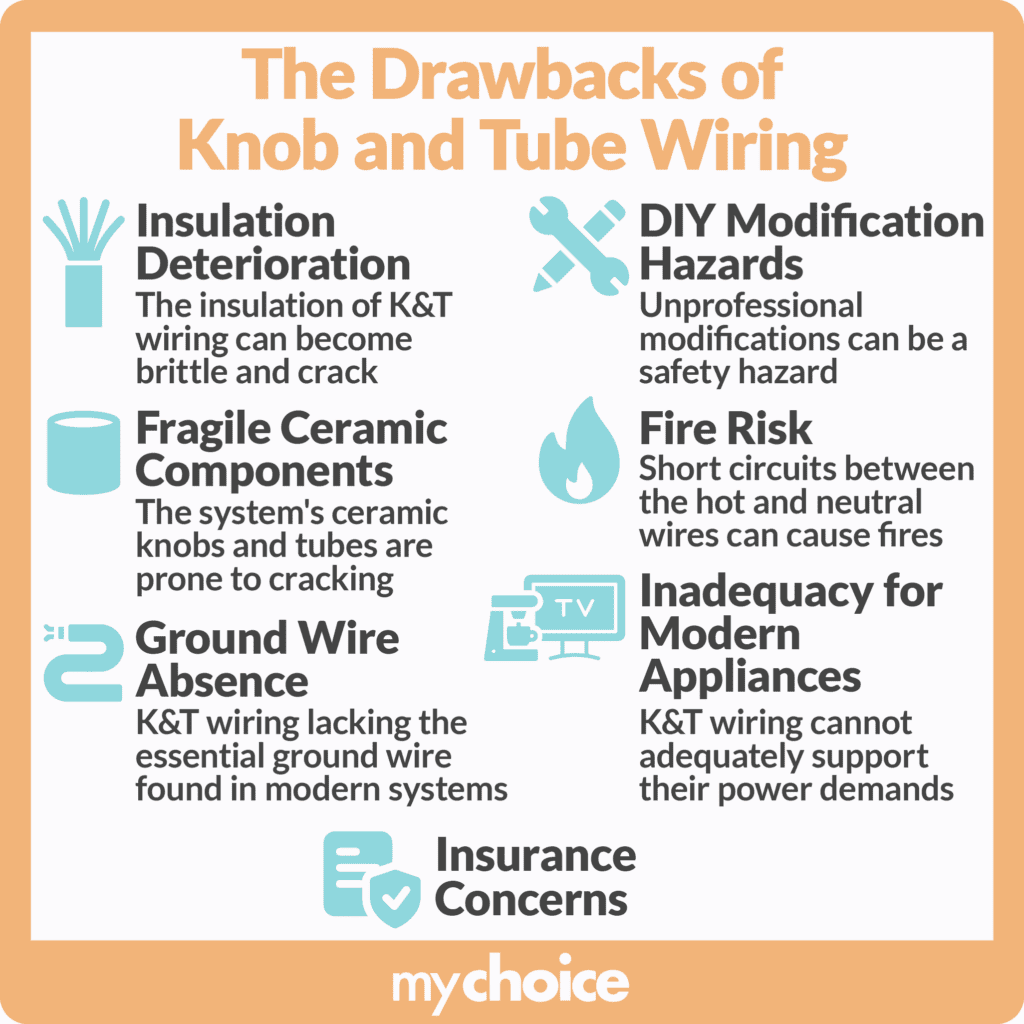If you live in an older home in Ontario, you might have knob and tube wiring installed as your primary electrical system. This kind of electrical system poses a high fire risk and comes with some implications for home insurance.
Knob and tube wiring is an older type of electrical system that is no longer installed in new construction, though many heritage homes in Ontario still have this type of wiring installed. Knob and tube wiring systems don’t have a ground wire, unlike modern electrical systems. This means that they don’t support three-pronged plugs and are more prone to short circuits and electrical fires, especially with the demands of modern appliances.
Does home insurance cover knob and tube wiring? How dangerous is knob and tube wiring really? Read on to find out how having knob and tube wiring installed can affect your home insurance premiums.
Risks Associated With Knob and Tube Wiring
There are a variety of ways that knob and tube wiring can become a fire hazard:
- Overloading: Knob and tube wiring systems weren’t designed to handle the demands of modern appliances. Plugging in many appliances can overload the circuits, significantly increasing the risk of electrical fire.
- Moisture problems: Knob and tube wiring is not safe when around sources of moisture, as water can seep between cracks in the ceramic and get into the copper wiring. This can cause sparks and short circuits, making it a huge fire risk.
- Deterioration: The porcelain tubes and knobs can crack and degrade over time. Since most knob and tube wiring systems were installed many decades ago, it’s likely that they’ve developed cracks and other sorts of damage.
- Overheating: Having insulation installed over the knob and tube wiring can stop the wires from dissipating heat properly. This can lead to overheating, causing the wires to catch on fire.
- No ground wire: Knob and tube wiring systems lack a grounding wire, making them incompatible with three-pronged appliances. This can damage modern appliances and increase the chances of a short circuit.

Knob and tube wiring is not dangerous on its own, but a combination of deterioration from age, modifications, and modern electrical demands can make this type of wiring unsafe for most homes. The biggest danger of knob and tube wiring is the fire risk that it poses, which can mean the need for home fire insurance.
If knob and tube wiring is properly maintained and hasn’t been modified, you can significantly reduce the dangers it poses to your home. However, insurers will still consider your home a high-risk property until you replace your knob and tube wiring system.
Will Insurance Cover Knob and Tube Wiring?
Depending on your insurance provider and policy, your home insurance may cover knob and tube wiring. Insurance companies may refuse to issue you a home insurance policy if you don’t replace knob and tube wiring in your home, though some insurers will still cover you for a much higher premium with specific conditions. Insurance providers that will cover your home can also demand a detailed inspection of your electrical system to assess the extent and condition of your knob and tube wiring.
The Insurance Bureau of Canada (IBC) heavily recommends the removal or replacement of knob and tube wiring, as it is considered a high-risk factor for insurance policies. Unfortunately, insurance companies won’t cover the cost to replace knob and tube wiring, but replacing your knob and tube system can improve your insurance premiums and expand your policy coverage options.
Knob and Tube Wiring in Ontario
For Ontario homeowners, the considerations for knob and tube wiring are largely the same as in other regions. Since there is an abundance of older homes in Ontario, homeowners need to be especially vigilant when assessing the presence and condition of knob and tube wiring.
Like other regions in Canada, Ontario’s building codes and regulations don’t allow knob and tube wiring to be used in new construction. Homeowners planning to renovate their homes may need to completely replace existing knob and tube wiring in compliance with the Ontario Electrical Safety Code.

How Much Does it Cost to Replace Knob and Tube Wiring?
The cost to replace knob and tube wiring depends on the size of your home, how complex the job is, and the local labour rates of professional electricians. Taking all of those factors into consideration, the average knob and tube wiring replacement cost can vary from $5,000 to $15,000.
Replacing your knob and tube wiring system isn’t cheap but is an investment in one’s peace of mind and safety, with the positive side effect of potentially lowering insurance premiums.
Proper Disposal of Knob and Tube Wiring
When you’ve gotten your knob and tube wiring system replaced, you need to dispose of it properly. There are a couple of ways to properly get rid of your old wiring system:
- Have a professional electrician take your old wires.
- Place them within e-waste drop-off containers.
- Donate your old wires to be reused.
Key Advice From MyChoice
- Many insurers will require you to replace knob and tube wiring before they consider giving you home insurance.
- Replacing knob and tube wiring can cost between $5,000 and $15,000 depending on the size of your home and the complexity of the system.
- You can lower your insurance premiums and get better coverage if you replace your knob and tube wiring with a modern electrical system.
- Keeping your knob and tube wiring system well-maintained can decrease the risk of it catching on fire.
- Knob and tube wiring doesn’t support appliances with three-pronged plugs, and can be overloaded if you use too many appliances at once.
- Hire a professional electrician or home inspector to conduct an assessment of your home’s knob and tube wiring system.








